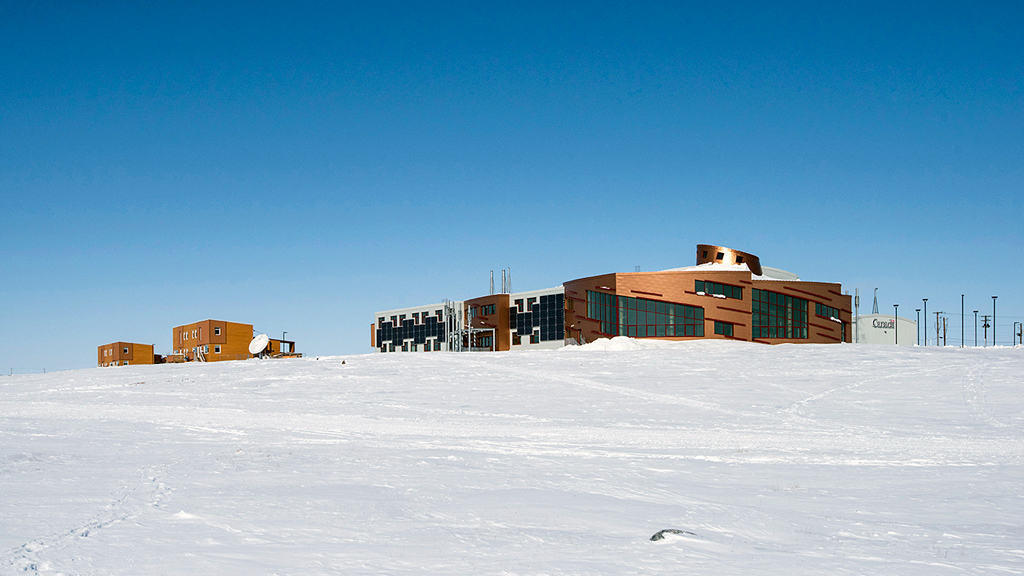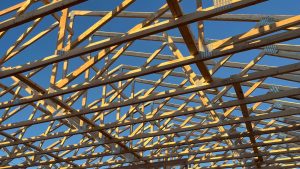When the Montreal-based joint venture of EVOQ Architecture and NFOE was retained to design a research station in the Arctic, its mandate included integrating the facility into the local Inuit community.
“This represented both a challenge and a welcome opportunity,” says architect Alain Fournier, a founding partner in EVOQ, who leads his firm’s projects north of the 55th parallel.
Located in the hamlet of Cambridge Bay, Nunavut, the Canadian High Arctic Research Station (CHARS) brings science and technology and traditional Inuit knowledge under one roof.
Built as part of Canada’s northern strategy, the facility will provide a year-round presence and complement the network of research facilities across Canada’s North.
Construction of the station, which is now largely operational, was spearheaded by Indigenous and Northern Affairs Canada (INAC) — now Crown-Indigenous Relations and Northern Affairs Canada.
The two-storey, 4,800-square-metre main building houses cutting-edge laboratories as well as public spaces. The campus also includes a field and maintenance building and residences for researchers.
The budget for architectural design, construction, equipment and fit-up of the campus is estimated at $204 million. The official opening is pending.
The station has garnered attention not only for its state-of-the-art facilities but also for its integration of Inuit community-oriented spaces, values, art and heritage.
“While Canada has a number of research facilities in the North, what’s unique about this project is that it is actually integrated into an Indigenous, and in this case, Inuit community,” Fournier said.
The key to success was the fact the community was involved in the project from the very outset, said Fournier, whose firm has worked in the North for 35 years.

Meetings were held at various milestones during the design development process.
“This was really at the heart of our being able to develop a design that evoked the Inuit culture and more specifically the culture of the host Copper Inuit community,” Fournier said.
Both the process leading to the design and the design of the station itself were derived from a number of Inuit Qaujimajatuqangit principles, meaning “that which has always been known.”
Incorporation of these principles was done at the suggestion of the community, which has a population of about 1,700.
The planning principle of free, open, interconnected spaces is used in the layout of the public spaces. Design of these spaces was inspired by the qaggiq, a communal igloo, where locals and scientists can interact. Large artwork by Inuit artists are woven into the fabric of the station, including in the floors and glazing, giving “shape and meaning” to the building’s interior, the architect explained.
“The artworks reinforce the expression of Inuit culture and work hand in hand with the architectural narrative,” Fournier said.
Artists were commissioned to produce works following a competition held across the Inuit Nunangat territories, said to be a first of its kind in Canada.
Fournier said the main building’s exposed wood structure is intended to convey the ingenuity of the many Inuit-designed, stick-built assemblies. Copper-coloured cladding is a nod to the host community.
LEED Gold, which is more commonly applied in southern environments, is being targeted. Fournier said the architects “translated and adapted” the system for application in Arctic conditions.
A construction management contract was awarded to EllisDon in joint venture with NCC Dowland Construction Ltd., a Northern firm.
A number of Inuit-owned or Nunavut Tunngavik Inc. registered firms participated in construction of the campus.
“Community integration involved more than just design,” Fournier said. “It also meant ensuring that jobs were created for local Inuit firms not just during construction but also when the station is up and running.”
Given its location, the project has posed certain challenges in terms of construction — among them coping with sometimes harsh weather conditions, and ferrying personnel and materials to the site.
Cambridge Bay is located on the southeast coast of Victoria Island.
“It’s all about logistics,” Fournier said.
In a number of cases, building materials were shipped to the site from the port of Valleyfield, about 70 kilometres southwest of Montreal, up the St. Lawrence River and the Labrador coast, and then across the Northwest Passage.
Materials were shipped from the West Coast as well.
“There is a short shipping season and it is often unpredictable,” Fournier said. “You’re never quite sure when the ice is going to break up and free up access to the community.”
INAC opted for the construction management project delivery approach in part to maximize participation by local contractors, he said.
“In this way, it was possible to carve out smaller construction packages.”
Construction of the campus began in summer 2014. The location was chosen following consultations with community members including elders and hamlet staff and an assessment of the station’s requirements.
The project manager was Public Services and Procurement Canada.
The facility is being operated by Polar Knowledge Canada, a federal agency responsible for advancing Canada’s knowledge of the Arctic and strengthening Canadian leadership in polar science and technology.












Recent Comments
comments for this post are closed